Click on images to enlarge
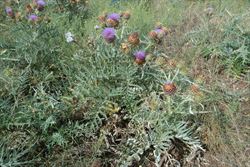
infestation (Photo: Rob and Fiona Richardson)
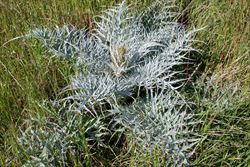
habit prior to flowering (Photo: Rob and Fiona Richardson)
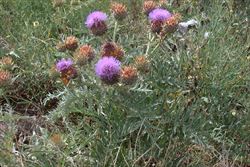
habit in flower (Photo: Rob and Fiona Richardson)
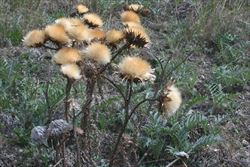
habit in fruit (Photo: Rob and Fiona Richardson)
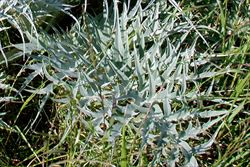
large, deeply-divided, lower leaf with spine-tipped margins (Photo: Rob and Fiona Richardson)
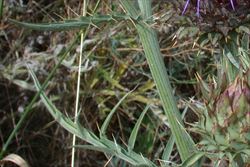
stem and much smaller, less-divided, upper leaves (Photo: Rob and Fiona Richardson)
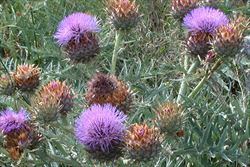
large flower-heads (Photo: Rob and Fiona Richardson)
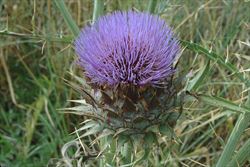
flower-head (Photo: Rob and Fiona Richardson)
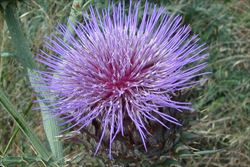
close-up of flower-head (Photo: Rob and Fiona Richardson)
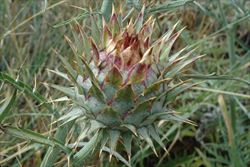
immature flower-head showing numerous purple-tinged, spine-tipped, floral bracts (Photo: Rob and Fiona Richardson)
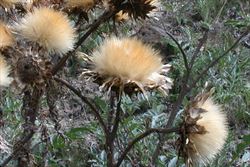
mature flower-heads with numerous fluffy seeds (Photo: Rob and Fiona Richardson)
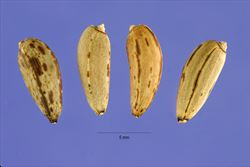
close-up of seeds with fluffy hairs removed (Photo: Steve Hurst at USDA PLANTS Database)
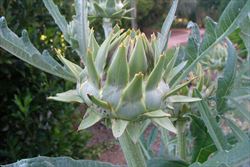
globe artichoke (Cynara scolymus), with spineles leaves and green floral bracts (Photo: Sheldon Navie)
Scientific Name
Cynara cardunculus L.
Synonyms
Cynara cardunculus L. subsp. flavescens Wiklund
Family
Asteraceae (Queensland, New South Wales, the ACT, Victoria, Tasmania, Western Australia and the Northern Territory)
Compositae (South Australia)
Common Names
artichoke thistle, cardoon, desert artichoke, globe artichoke, Scotch thistle, Spanish artichoke, wild artichoke
Origin
This species is native to the Mediterranean region (i.e. the Canary Islands, Greece, Italy, Yugoslavia, southern France, Portugal, Spain, north-western Libya, northern Morocco, Tunisia, Cyprus and Turkey).
Cultivation
This species was occasionally cultivated as a garden ornamental and/or culinary plant during the early stages of settlement in Australia. However, it is not known to have been deliberately cultivated for many years.
Naturalised Distribution
A widely distributed species that is naturalised mainly in the southern parts of Australia. It is most common in Victoria and south-eastern South Australia, and has a scattered distribution in the sub-coastal regions of New South Wales. Also present in south-western Western Australia and south-eastern Queensland, and possibly naturalised in Tasmania.
Naturalised overseas in western USA (i.e. California, Oregon and Washington), Mexico, South America (i.e. Argentina, Brazil, Chile and Uruguay), UK and New Zealand.
Habitat
This species is mainly a weed of temperate regions, but it is also occasionally found in sub-tropical and semi-arid environments. It most commonly infests pastures, however it is also a weed of crops, grasslands, open woodlands, roadsides, gardens, waste areas and disturbed sites.
Habit
An upright (i.e. erect) and long-lived (i.e. perennial) herbaceous plant usually growing 75-150 cm tall, but occasionally reaching up to 2 m in height. This spiny 'thistle' forms a basal rosette of leaves during the early stages of growth.
Distinguishing Features
- a large long-lived 'thistle' that grows up to 2 m tall.
- it produces a rosette of large, deeply divided leaves (up to 120 cm long and 30 wide).
- these leaves have densely woolly undersides and their margins are armed with yellowish-orange spines (5-20 mm long).
- its thick upright stems are branched in their upper parts, strongly ribbed, and covered in a cottony down.
- its very large flower-heads (5-13 cm across) consist of many blue, pink or purple florets enclosed within several layers of large spine-tipped bracts.
- these flower-heads produce numerous large seeds (6-8 mm long) that are topped with large feathery hairs (25-40 mm long).
Stems and Leaves
The thick and rigid stems are upright (i.e. erect) and strongly ribbed lengthwise (i.e. longitudinally). They are covered in a cottony down and are usually branched in the upper parts.
The rosette leaves are very large (up to 120 cm long and 35 cm wide, but usually only about 50 cm long) and stalked (i.e. petiolate), while those that are alternately arranged along the upright stems are significantly smaller (i.e. 10-50 cm long) and the uppermost ones are stalkless (i.e. sessile). All leaves are deeply divided (i.e. pinnatisect), with the lobes often partly divided again (i.e. pinnatifid). Their upper surfaces are greyish-green and slightly hairy (i.e. puberulent), while their lower surfaces are whitish woolly in nature, due to a dense covering of hairs (i.e. they are tomentose). The tips and margins of the leaves are armed with yellowish-orange coloured spines (5-20 mm long). The leaf stalks (i.e. petioles) are also covered in spines.
Flowers and Fruit
The large flower-heads (i.e. capitula) are borne singly at the tips of the branches on thick stalks (i.e. peduncles) 1-6 cm long. They consist of many blue, pink or purple (rarely white) coloured florets (about 5 cm long) arranged on a fleshy base (i.e. receptacle) and enclosed within numerous large bracts (i.e. an involucre). The bracts are hairless (i.e. glabrous), often purplish in colour, and taper to end in a stout, flattened spine. These flower-heads (5-13 cm across) are almost round in shape (i.e. sub-globular) and are produced mostly during late spring and summer.
The seeds (i.e. achenes) are quite large (6-8 mm long), four-sided and smooth in texture. They are light grey, brown or black in colour and sometimes also have lengthwise (i.e. longitudinal) streaks. These seeds and are topped with a ring (i.e. a pappus) of large feathery hairs (25-40 mm long) that readily fall off (i.e. they are deciduous).
Reproduction and Dispersal
This species reproduces by seed, and also re-grows each year from a long-lived (i.e. perennial) underground crown and taproot.
The seeds may be dispersed by the wind, but they are relatively heavy and don't travel very far. They may also be spread by animals (e.g. sheep, cattle, birds and mice), water, vehicles, in mud and in dumped garden waste.
Environmental Impact
Artichoke thistle (Cynara cardunculus) is regarded as a significant environmental weed in Victoria and an environmental weed in South Australia and Tasmania. Though it is largely known as a pest of agricultural areas (particularly pastures) and disturbed sites, it also invades natural habitats (e.g. grasslands, open woodlands, and wetlands and riparian areas in drier regions). It can easily dominate the vegetation in densely infested areas, smothering most pasture species and native ground-dwelling plants.
Artichoke thistle (Cynara cardunculus) is listed as a priority environmental weed in one Natural Resource Management region and occurs in conservation areas in South Australia (e.g. Marino Conservation Park, Greenhill Recreation Park and Moana Sands Conservation Park) and Victoria (e.g. Pine Grove Nature Conservation Reserve). This species is also listed among the handful of species that are thought to be the highest weed threats to native lignum-dominated swamp communities in north-western Victoria.
Other Impacts
Artichoke thistle (Cynara cardunculus) is a significant weed affecting the pastoral industry in many regions of southern Australia. Dense infestations of draw significant moisture and nutrients from the soil and replace useful pasture species. The prickly nature of the leaves deters sheep and cattle from areas of heavy infestation, further reducing the productivity of pastures. As a weed of crops it impedes harvesting operations as well as reducing yields through competition.
Legislation
This species is declared under legislation in the following states and territories:
- New South Wales: Class 5 - a restricted weed which must not be sold, bought or knowingly distributed (throughout the entire state).
- South Australia: 3* - declared in Class 3l, a designation for agricultural weeds. This species is only required to be controlled in part of the state. For information on what areas this declaration covers and what control measures are required please see the Consolidated Proclaimed Plants List, produced by Primary Industries and Resources, South Australia.
- Tasmania: D - the importation or sale of this species is prohibited and measures to reduce its population in an area, eradicate it from an area, or restrict it to a particular area may be required.
- Victoria: P1 - a prohibited weed that must be eradicated or controlled on land in the Goulburn region, and C4 - a regionally controlled weed meaning landholders must take all reasonable steps to control it and prevent its spread on their land and the roadsides which adjoin their land (in the Mallee, North Central, Port Phillip West and Port Phillip East regions).
- Western Australia: P1 - trade, sale or movement into the state prevented, and P2 - to be eradicated (throughout the entire state).
Management
For information on the management of this species see the following resources:
- the Victorian Department of Sustainability and Environment Landcare Note on this species, which is available online at http://www.dse.vic.gov.au.
- the Western Australian Department of Agriculture and Food information page on this species, which is available online at http://www.agric.wa.gov.au.
- the Land and Water Australia fact sheet on Managing Weeds in Riparian Areas, which is available online at http://www.lwa.gov.au.
Similar Species
Artichoke thistle (Cynara cardunculus) is very similar to globe artichoke (Cynara scolymus) and relatively similar to variegated thistle (Silybum marianum). These species can be distinguished by the following differences:
- artichoke thistle (Cynara cardunculus) has greyish-green leaves that are divided almost to the midrib (i.e. pinnatisect). Its flower-head bracts are broad, flattened, pointed, and taper to relatively short and very broad (i.e. stout) spines.
- globe artichoke (Cynara scolymus) has greyish-green leaves that are divided almost to the midrib (i.e. pinnatisect). Its flower-head bracts are broad, flattened, not very pointed (usually ovate in shape) and spineless.
- variegated thistle (Silybum marianum) has variegated leaves that are divided less than half-way to the midrib (i.e. pinnatifid). Its flower-head bracts have broad bases and curled upper parts that end in long narrow spines.
Artichoke thistle (Cynara cardunculus) may also be confused with many other thistles (i.e. Cirsium spp., Carduus spp. and Onopordum spp.). However, these species can all be easily distinguished from artichoke thistle (Cynara cardunculus) by the 'wings' on their stems, which usually extend from their leaf bases.

